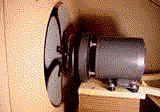
A new type of Loudspeaker
A motor controller and electric motor rotate a set of blades at a constant speed. The rotary woofer pitch mechanism uses a conventional voice coil and magnet assembly. This is connected to your amplifier to pitch blades in proportion to the applied audio signal. As the blades pitch while rotating a pressure wave is generated, the degree of pitch controls the amplitude of the pressure wave. Air is allowed to transition through the blades. Thus oscillating the pitch of the blades creates sound while they are rotating .
The advantage of the Thigpen rotary woofer (patent pending) and the conceptual jump occurs in understanding the impedance match with the air in this approach to sound reproduction versus the impedance mismatch with the air in a cone woofer.
The air density is much too low to be a good impedance match with a cone loudspeaker. Take your hand and try and grab some air or flatten your hand and try and push some air as fast as you can. This illustrates the futility of trying to move air to create a small amount of pressure at low frequencies with a cone speaker. You can barely feel the resistance of the air to the motion of your hand, the air molecules simply slip around.
Now take your hand while driving down the road and stick it outside the window of a car. The faster you go the thicker the air feels. Also a simple twisting of your hand enables you to deflect a large number of air molecules. This illustrates the way the rotary woofer works and how effectively it couples moving blade surfaces to the air to create sound pressure.
A conventional speaker cones displacement must increase four times for each halving of frequency to maintain the same output. This is why conventional cone woofer companies are trying to develop “long throw” woofers. Although inefficient, cone woofers work fine above 40Hz. Below 40Hz however cone woofers quickly run out of travel and the output diminishes rapidly.
The rotary woofer represents a much more efficient way to move air at low frequencies. Because of aerodynamic affects and swept area versus frequency, the displacement of the rotary woofer pitch mechanism barely has to increase at all as the frequency goes down. We can now listen to never heard before very low frequencie sounds.